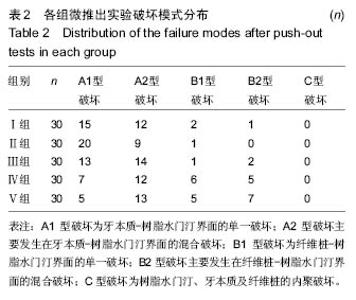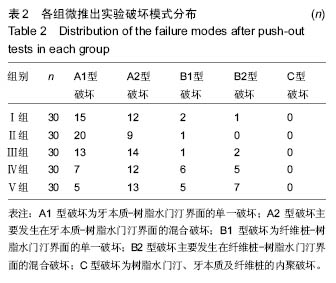| [1]Coelho CS,Biffi JC,Silva GR,et al.Finite element analysis of weakened roots restored with composite resin and posts.Dent Mater J.2009;28(6):671-678.
[2]叶莲妹,林萍,孟玉坤.176例纤维桩与金属铸造桩桩核冠修复病例的短期临床效果比较研究[J].重庆医学, 2015, 44(32):4512-4516.
[3]孙岩.两种不同树脂水门汀粘接纤维桩的临床疗效比较[J].中国现代医生,2013,51(18):144-145.
[4]贺乃玲,曹秀华,田英利.玻璃纤维桩在恒上前牙外伤性牙冠折断自体牙再接术中的应用[J].山西医药杂志, 2014, 43(1):73-75.
[5]刘迪生,翟绍丞,唐亮.树脂粘接剂对纤维桩粘接效果的影响[J].国际口腔医学杂志,2014,41(2):180-183.
[6]刘莉,陈小冬.不同树脂粘接剂对纤维桩粘接强度及断裂界面的作用[J].中国组织工程研究, 2014,18(12):1852-1857.
[7]Kanca J 3rd.Improving bond strength through acid etching of dentin and bonding to wet dentin surfaces.J Am Dent Assoc.1992;123(9):35-43.
[8]Mazzitelli C,Monticelli F,Osorio R,et al.Effect of simulated pulpal pressure on self-adhosive cements bonding to dentin.Dent Mater.2008;24(9):1156-1163.
[9]Broyles AC,Pavan S,Bedran-Russo AK.Effect of dentin surface modification on the microtensile bond strength of self-adhesive resin cements.J Prosthodont.2013; 22(1):59-62.
[10]郭可武,张保卫.自粘接型树脂水门汀的研究进展[J].口腔材料器杂志,2011,20(2):92-94.
[11]Calixto LR,Bandeca MC,Clavijo V,et al.Effect of resin cement system and root region on the push-out bond strength of a translucent fiber post.Oper Dent.2012; 37(1):80-86.
[12]Naumann M,Blankenstein F,Dietrich T.Survival of glass fibre reinforced composite post restorations after 2 years-an observational clinical study.J Dent. 2005; 33(4):305-312.
[13]Monticelli F,Grandini S,Goracci C,et al.Clinical behavior of translucent fiber post: a 2-year prospective study.Int J Prosthodont.2003;16(6):593-596.
[14]Chigira H,Koike T,Hasegawa T,et al.Effect of the self-etching dentin primers on the bonding efficacy of a dentin adhesive.Dent Mater J.1989;8(1):86-92.
[15]Monticelli F,Osorio R,Mazzitelli C,et al.Limited decalcification/diffusion of self-adhesive cements into dentin.J Dent Res.2008;87(10):974-979.
[16]Pavan S,dos Santos PH,Berger S,et al.The effect of dentin pretreatment on the microtensile bond strength of self-adhesive resin cements.J Prosthet Dent. 2010;104(4):258-264.
[17]焦纪兰,曾利伟,周灏,等.不同牙本质清洁剂对牙本质与自粘接树脂水门汀粘接强度的影响[J].华西口腔医学杂志, 2015,33(3):306-310.
[18]常颖,王学玲,王维丽,等.桩道牙本质壁的不同处理对纤维桩粘接强度的影响[J].口腔颌面修复学杂志, 2015,16(3): 169-173.
[19]柳娟,朱亚琴.不同根管牙本质表面处理对树脂水门汀粘接强度的影响[J].口腔材料器械杂志, 2013,22(3): 116-121.
[20]廖娟,费伟,郭俊,等.不同激光预处理对纤维桩与牙本质粘结强度影响的体外研究[J].激光杂志, 2014,35(11): 127-128.
[21]刘婧源,张晓,安婕.不同冲洗剂处理对纤维桩剪切粘接强度的影响[J].山东大学学报,2013,51(4):30-33.
[22]王霜剑,唐旭炎.根管内不同预处理对玻璃纤维桩粘接强度的影响[J].安徽医学,2015,36(8):920-923.
[23]李萌,李晓静,周唯,等.桩道酸蚀处理对自粘接树脂水门汀与纤维桩粘接性能影响的研究[J].临床口腔医学杂志, 2015,31(3):165-168.
[24]Goracci C,Sadek FT,Fabianelli A,et al.Evaluation of the adhesion of fiber posts to intraradicular dentin. Oper Dent.2005;30(5):627-635.
[25]Yang B,Ludwig K,Adelung R,et al.Micro-tensile bond strength of three luting resins to human regional dentin.Dent Mater.2006;22(1):45-56.
[26]Amaral CM,Peris AR,Ambrosano GM,et al.The effect of light-curing source and mode on microtensile bond strength to bovine dentin.J Adhes Dent. 2006;8(1): 41-45.
[27]Hikita K,Van Meerbeek B,De Munck J,et al.Bonding effectiveness of adhesive luting agents to enamel and dentin.Dent Mater.2007;23(1):71-80.
[28]赵三军,陈吉华.酸蚀时间对牙本质粘接界面纳米渗漏和粘接强度的影响[J].实用口腔医学杂志, 2009,25(1): 36-40 .
[29]Nakabayashi N,Kojima K,Masuhara E.The promotion of adhesion by the infiltration of monomers into tooth substrates.J Biomed Mater Res.1982;16(3):265-273.
[30]Van Landuyt KL,Snauwaert J,De Munck J,et al.Origin of interfacial droplets with one-step adhesives.J Dent Res.2007;86(8):739-744.
[31]Cantoro A,Goracci C,Papacchini F,et al.Effect of pre-cure temperature on the bonding potential of self-etch and self-adhesive resin cements.Dent Mater. 2008;24(5):577-583. |



